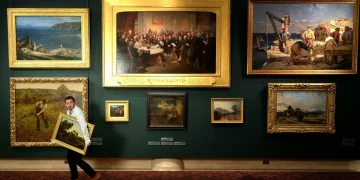The world has been facing the undeniable effects of climate change for decades, with shifting weather patterns, rising sea levels, and increasingly severe natural disasters. However, what may come as a surprise to many is how these environmental changes are affecting the world of rare collectibles. As environmental shifts create unexpected rarities, a new class of “climate change collectibles” is emerging, with certain items becoming increasingly valuable due to their rarity, significance, or the environmental factors surrounding their creation.
In this article, we will explore how climate change is influencing the collectibles market, highlighting specific categories of items that are gaining unprecedented value due to environmental shifts. We will also provide an in-depth analysis of the emerging collectibles that could potentially create new millionaires in the coming years. From rare natural artifacts to the increasingly scarce goods of the past, climate change is reshaping the way we view, value, and collect items from our planet’s history.
Environmental Shifts and the Creation of New Collectibles
As the effects of climate change intensify, certain geographical regions, ecosystems, and species are being altered or destroyed. While much of the media focus has been on the negative impacts of climate change, the changes happening in nature are also producing some unexpected and, in some cases, valuable consequences. Certain items, once abundant, are becoming rare, either due to the destruction of natural habitats, changes in ecosystems, or the effects of extreme weather events. This creates a new niche market for collectors who seek out these items, often willing to pay large sums for them.
From rare plant species and fossils to weathered artifacts or preserved objects from historically endangered locations, these “climate change collectibles” have taken on an entirely new significance. As these items become harder to obtain, their value grows exponentially. Let’s take a closer look at the various categories of collectibles that are being influenced by climate change.
Emerging Climate Change Collectibles
1. Rare Animal and Plant Specimens
One of the most direct effects of climate change is the alteration of ecosystems. Many species are at risk of extinction due to habitat destruction, changes in food sources, or warming temperatures. As certain species become increasingly rare, collectors are seeking out preserved specimens to commemorate and remember these once-abundant creatures.
For example, plants and animals that were once common in certain regions but are now endangered or extinct are becoming valuable collectibles. Collectors of natural history specimens, such as preserved insects, bones, and plants, are especially focused on rare or now-extinct species. For instance, certain species of insects and small mammals that have been wiped out by deforestation or climate shifts are now highly sought after by collectors, especially those who want to own pieces of nature before it is lost forever.
The growing interest in rare plant and animal species has resulted in an increase in the value of preserved specimens. Once widely available and relatively inexpensive, these items are becoming increasingly scarce, making them an attractive commodity for natural history collectors.
2. Fossils from Vulnerable Ecosystems
As climate change accelerates the extinction of certain species and transforms ecosystems, fossil collectors are finding that certain types of fossils have become more valuable. For example, fossils from regions that were once rich in biodiversity but are now threatened by environmental change, such as the melting of permafrost in the Arctic or the desiccation of formerly lush rainforests, are growing rarer and more coveted.
Fossils from these changing ecosystems—whether they are remnants of ancient plants, early forms of life, or extinct animals—have become highly valuable. Collectors are not just interested in these fossils for their scientific value, but also for their historical significance in the context of the environmental changes we are experiencing today. Items that once would have been disregarded or considered mundane are now regarded as crucial representations of the Earth’s shifting ecological landscape.
3. Dried and Preserved Pieces of Disappearing Ecosystems
As certain ecosystems disappear due to the effects of climate change, there is growing interest in collecting natural items from these areas. For instance, some rare trees in forests being impacted by deforestation or desertification are now being harvested and preserved for their unique wood, bark, and leaves. These preserved pieces may be sold as souvenirs or collectibles, but they also serve as poignant reminders of the fragility of nature.
Similarly, endangered coral reefs, which are highly sensitive to changes in ocean temperature and acidity, have led to a new form of collectible: dried coral. As the reefs experience bleaching and die-off due to warming oceans, coral pieces that are preserved in various forms—ranging from sculptures to natural jewelry—are becoming increasingly sought after. These items are not only valuable because of their scarcity, but also because they act as a symbol of the dramatic changes taking place under the surface of the ocean.
4. Climate Artifacts from Natural Disasters
Another emerging category of climate change-related collectibles includes objects salvaged from natural disasters. Extreme weather events, such as hurricanes, wildfires, and floods, are becoming more frequent and intense as a result of climate change. As a result, certain objects or materials that are associated with these disasters are being collected as part of a broader effort to document and commemorate these significant events.
For instance, pieces of charred wood from a devastating wildfire or remnants of buildings that have been swept away in floods are now being preserved and collected. Some of these objects are framed or displayed in museums, while others are sold as part of a new genre of collectible memorabilia linked to climate change. These objects serve as reminders of the increasing frequency and severity of natural disasters, and they hold value for collectors interested in preserving pieces of history associated with these unprecedented events.

5. Climate-Themed Artworks and Sculptures
As climate change has become an ever more pressing issue, many artists are using their work to reflect on the environmental crisis. Climate-themed art is one of the fastest-growing segments in the art world, with numerous pieces addressing the impacts of global warming, deforestation, and pollution. Some of the most valuable artworks are created from recycled materials, using plastic debris found on beaches or in oceans, for example.
These works, which merge art and environmentalism, are increasingly being sought after by collectors and investors. As the crisis deepens, artworks that explore these themes are not only valued for their aesthetic beauty but also for their capacity to provoke thought and spark action on the climate crisis. Collectors are now willing to pay large sums for climate-themed art, not only as a statement of social responsibility but also as a way of securing a valuable and meaningful investment.
6. Climate Change-Influenced Wine and Agricultural Products
One of the more unusual emerging trends in the climate change collectible market involves wine and agricultural products that are being influenced by climate shifts. For example, certain wine regions that were once ideal for growing specific grape varieties are now seeing changes in temperature and rainfall patterns, leading to new wines with unique flavors and characteristics.
These climate change-influenced wines, as well as rare agricultural products such as heirloom fruits and vegetables, are being marketed as limited-edition collectibles. The scarcity of certain varieties, combined with the unique flavors that climate change has produced, has made these products highly sought after by connoisseurs and collectors alike. Some collectors are even investing in rare agricultural products with the expectation that they will become more valuable as climate change continues to reshape the landscape of farming and food production.
The Impact of Climate Change Collectibles on the Investment Market
As with any emerging collectible market, climate change-related collectibles have the potential to generate significant wealth for savvy investors. As certain items become more scarce due to environmental changes, their value will likely continue to rise. Rare plant specimens, fossilized remains, and climate-themed art are just a few examples of the items that could become increasingly valuable as they become more difficult to obtain.
Collectors who are quick to recognize the value of these items, and who can afford to invest in them, stand to make substantial profits. However, as with any collectible market, the value of these items can fluctuate depending on various factors, including the rate of climate change, shifts in public interest, and the continued rarity of the items in question. Investors will need to carefully monitor the market and stay informed about the evolving effects of climate change in order to make wise investment choices.
Conclusion: A New Era of Collecting
Climate change is fundamentally altering the world around us, and as it does, it is creating new opportunities for collectors to acquire rare, valuable, and historically significant items. From preserved specimens of endangered species to artifacts from natural disasters, the collectibles market is undergoing a transformation driven by environmental shifts. The items that are becoming rare due to climate change represent not only valuable commodities but also poignant reminders of the fragility of the world we live in.
As climate change continues to reshape the planet, the market for climate change collectibles is likely to grow. Savvy collectors who are able to identify these emerging trends and invest early stand to benefit from the increasing scarcity of certain items. Whether it’s rare natural artifacts, climate-themed art, or agricultural products that have been shaped by environmental shifts, these collectibles are paving the way for a new generation of millionaire collectors who are both preserving the past and investing in the future.

































